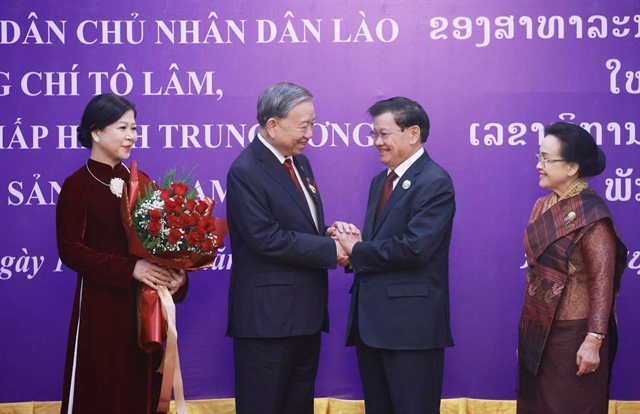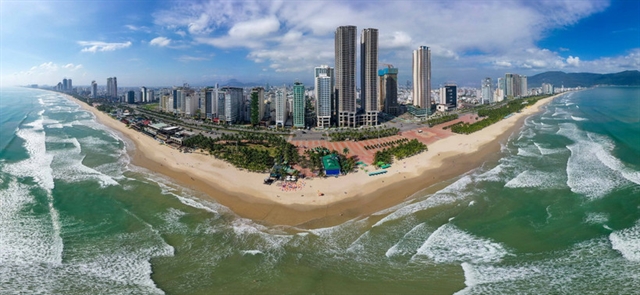 Opinion
Opinion

Henry Tillman and Phạm Thanh Long, co-authors of Việt Nam's Foreign Investment Trends - Private Equity, Energy Transition, Infrastructure, Venture Capital & IPOs, the latest publication by Asia Investment Research, talked to Việt Nam News reporter Nguyễn Hằng about the current situation of energy transition in Việt Nam as well as opportunities and challenges in attracting Foreign Direct Investment (FDI) in Việt Nam in the future
.JPG) |
| Henry Tillman, co-author of Việt Nam's Foreign Investment Trends - Private Equity, Energy Transition, Infrastructure, Venture Capital & IPOs. — Photo courtesy of Henry Tillman |
Could you please tell us the objectives of the latest digital Asia investment study on Việt Nam's Foreign Direct Investment Trends – Private Equity, Energy Transition, Infrastructure, and Venture Capital & IPOs (initial public offerings)?
Henry: Virtually the whole world relies on FDI data when preparing financial investment stories. We have found that FDI encompasses slightly over 50 per cent of all data as it excludes small investments such as Venture Capital, which is labour intensive to locate but useful in tracking data for future growth industries. So, once per quarter, Asia Investment Research chooses an emerging market country where we use all investment data, both FDI and below FDI, to track the growth industries being built or transitions occurring.
Our goal is to provide detailed data on energy transition and infrastructure as well as capital flows in Private Equity and Venture Capital over the past two years to Governments, rating agencies, corporate and institutional investors- specifically on information they cannot obtain from major investment banks or rating agencies- to adjust for current realities, and not rely on the past perceptions.
 |
| Phạm Thanh Long, co-author of Việt Nam's Foreign Investment Trends - Private Equity, Energy Transition, Infrastructure, Venture Capital & IPOs. — Photo courtesy of Phạm Thanh Long |
Long: The study aims to achieve several key objectives. In term of investment trends’ assessment, the study seeks to provide a comprehensive assessment of the recent trends in foreign investments, particularly from European Union (EU) countries, in Việt Nam. It aims to highlight the shifts in investment patterns over the past two years. In term of strategy development analysis, one of the primary objectives is to analyse the strategic development of EU countries in their investment approach towards Việt Nam. This involves understanding the evolving strategies that EU investors have adopted to navigate the Vietnamese market.
In term of cross-border investment insights, the study aims to shed light on specific cross-border investments made by EU countries in Việt Nam. This includes identifying key investments that have taken place in various sectors, such as private equity, energy transition, infrastructure, venture capital, and IPOs. By examining the developments of the past two years, the study intends to provide insights into the future directions of EU investments in Việt Nam. This involves predicting potential areas of growth and expansion in the Vietnamese market. In term of impact of EU-Việt Nam Free Trade Agreement (EVFTA), the study also considers the initial impact of the EVFTA that came into effect in August 2020. It assesses how this trade agreement has influenced trade and investment between the EU and Việt Nam, particularly in sectors like renewable energy.
In term of economic growth analysis, a key objective is to evaluate the contributions of EU investments, especially in strategic sectors like renewable energy, to Việt Nam's economic growth. It seeks to quantify the economic impact of these investments on both Việt Nam and the EU. In term of identifying investment opportunities, the study aims to identify investment opportunities in Việt Nam, focusing on sectors like energy transition, infrastructure development, venture capital, and IPOs. This information can be invaluable to potential investors and policymakers.
In term of risk assessment, it is the assessment of risks associated with foreign investments in Việt Nam. This involves evaluating factors such as political stability, regulatory changes, and market volatility. In term of policy recommendations, based on the findings, the study may provide policy recommendations to both EU countries and Vietnamese authorities. These recommendations can help create a conducive environment for foreign investments and foster economic cooperation.
Lastly, the study aims to disseminate its findings to relevant stakeholders, including investors, government agencies, and businesses, to enhance their understanding of the evolving investment landscape in Việt Nam and promote informed decision-making. In summary, the study serves as a valuable tool for understanding the dynamics of EU investments in Việt Nam, assessing their impact on the Vietnamese economy, and providing insights into future investment opportunities and strategies in key sectors.
Part of the research is about the energy transition from coal and hydropower to renewable energy in Việt Nam. How do you assess the current situation of energy transition in Việt Nam and could you suggest some solutions to help the country to realise the Net Zero goal by 2050?
Henry: Almost no one in the west is aware of Việt Nam’s meteoric rise from its 196th global solar ranking in 2010 to ninth place in 2021 (rising above both Spain and France). By 2021, Việt Nam had become the third largest solar market in the world. Not surprisingly the existing grid was not prepared for this burst of growth - and without adequate storage a waste of energy, leading to government restrictions on solar growth. It also led to a shift to wind power. Our paper sets out the rapid development of wind over the past three years via partnerships with leading wind players in based in Asia and across the EU. Việt Nam has vast offshore wind capabilities of up to 600GWs.
In our research, we also set out the two programmes agreed towards net zero, consisting of Just Energy Transition Partnership (JETP) and the Việt Nam’s National Power Development Plan 8. The JEPT partnership was formed in December 2022, and includes the United States, the United Kingdoms, France, Germany, Italy, Canada, Japan, Norway and Denmark. The JETP plans to mobilise an initial US$15.5 billion of public and private finance over the three to five years to support Việt Nam's green transition.
I May 2023, Việt Nam’s Prime Minister approved the National Power Development Plan 8, in the period 2021-30, with a vision to 2050. The plan involves new energy sources, smart grid development, and a balancing of solar, wind, and hydropower.
Việt Nam received US$4.3 billion in FDI in the first quarter of this year, down 2.2 per cent from a year earlier. By the end of April 2023, the amount increased to $8.9 billion. What are the opportunities and challenges in attracting FDI in Việt Nam in the future?
Long: Việt Nam has significantly improved its legal framework for foreign direct investment (FDI) in recent years. Clear and investor-friendly regulations attract foreign investors, as they provide a sense of security and predictability.Việt Nam has a young and dynamic workforce. Investing in human resource development can make the country more attractive to FDI. A well-educated and skilled workforce can enhance productivity and innovation.
Next, infrastructure development is crucial for FDI, and Việt Nam has been investing in this area. A stable electricity supply is vital for businesses to operate efficiently, and improving infrastructure can reduce transportation costs and boost competitiveness. Another opportunity is that streamlining administrative procedures and enhancing transparency can significantly reduce the bureaucratic hurdles for investors. Efficient processes make Việt Nam more attractive for FDI. In term of access and Incentivise Local Investors for Public-private partnership (PPP) with Foreign Partners, PPP can help attract FDI by leveraging both domestic and foreign resources for infrastructure and development projects.
Encouraging local investors to collaborate with foreign partners can be mutually beneficial. Việt Nam can tap into international funding sources like development banks and foreign investment funds. Collaborating on key projects with international partners can bring invaluable expertise and capital. A large and growing domestic market can be a significant draw for FDI. Việt Nam's expanding middle class provides a substantial consumer base for various industries. A stable and supportive policy environment is essential for attracting FDI. Clear policies catering to various industries' needs can make Vietnam more appealing.
Việt Nam has the potential to attract significant FDI in the coming years, but it must address various challenges to capitalise on these opportunities. Consistency, transparency, infrastructure development, and a skilled workforce are key factors in ensuring sustained and robust FDI inflow.
Specifically, maintaining consistency and clarity in these regulations for FDI is essential. Frequent changes or ambiguity in laws can deter potential investors, as it increases the risk associated with their investments. Việt Nam should aim for stability and transparency in its legal framework. To fully harness the opportunity of human resource development, Việt Nam needs to address challenges like the skills gap, labour market reforms, and aligning education and training programs with the needs of industries that attract FDI.
Sustaining these improvements and ensuring that infrastructure development keeps pace with FDI inflow is also a challenge. Funding and effective project management are key factors to overcome. Implementing the administrative reforms at all levels of government and ensuring they are consistently applied can be challenging. Political will and ongoing monitoring are necessary to maintain transparency and efficiency. Balancing the interests and incentives of both local and foreign investors in PPP projects can be complex. Ensuring fair terms and effective risk-sharing mechanisms is essential. Competition for international funding can be intense, and securing financing may require meeting stringent criteria. Efficient project selection and management are essential for success.
Ensuring equitable access to this market and addressing potential market distortions is crucial. Additionally, maintaining market growth and stability amid economic fluctuations is a challenge. Striking the right balance between support and regulation is tricky. Regular policy reviews and feedback mechanisms with investors can help maintain consistency and relevance in FDI policies. — VNS
* Henry Tillman is one of primary contributors of the Asia Investment Research with more than 35 years experience as an international banker, based mostly from London. Prior to that, he had senior Executive Management roles at BZW (London) and at ABN Amro (Wholesale ExCo Board) where he had global roles with a focus on Asia and since 1996.
* Phạm Thanh Long is a senior research co-ordinator of Science Foundation Ireland's Insight Centre for Data Analytics. Prior to Insight, Long was a business development manager for University College Cork (UCC), Ireland, in ASEAN markets, where she worked with governments, universities, industries and education services for UCC internationalisation strategies.

.jpg)

.jpg)
